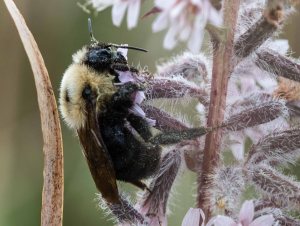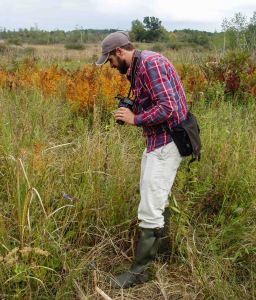by Carl Strang
Scott Namestnik is one of those wizard botanists who, I suspect, cheat by having built-in DNA barcode reading capability. How else to explain their ability to identify all those nonflowering stages of grasses and sedges, and their encyclopedic knowledge of plants both common and rare? Fortunately Scott, a professional ecological consultant, also is as personable a guy as you will meet, and loves to share his hard-earned knowledge. He agreed to guide me on my first visit to Springfield Fen, a state nature preserve in LaPorte County, Indiana, last week.

At this point in the autumn, the fen is beautiful with patches of royal ferns and poison sumac in full fall color.
The fen proved to be unremarkable in the singing insects we found, but there was much to enjoy. The highlight for both of us was neither botanical nor entomological.

It doesn’t look as cuddly in this photo as it did in person, but this massasauga was so small that it didn’t have a rattle on the end of its tail yet.
A bulge in the center of its body suggested that a frog or mouse had provided a final pre-hibernation meal for the little rattler. This is a species of concern in every state or province where it occurs.
Another interesting animal was an unfamiliar bumblebee.

The all-black though hairy abdomen, and the all-yellow thorax except for a black spot in the dorsal center, point to Bombus citrinus.
This is one of the cuckoo bumble bees, placed by some in the separate genus Psithyrus, the females of which take over the nests of typical bumblebees and have the workers raise their young.

Scott Namestnik said,
October 26, 2015 at 9:28 pm
Enjoyed our time in the field, Carl!